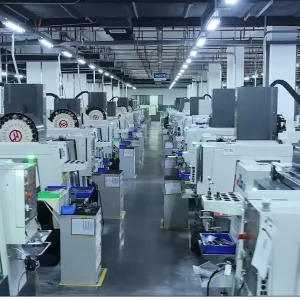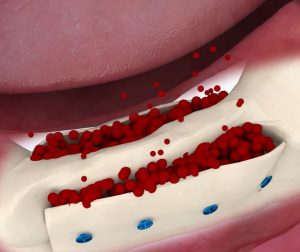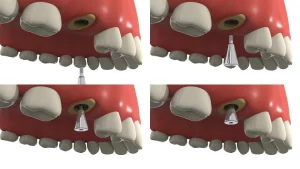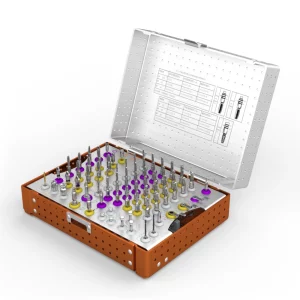In the journey toward achieving the perfect smile with dental implants, the healing abutment plays a crucial role. Serving as a bridge between the implant and the gum tissue, it not only provides a stable framework for the healing of the gums but also effectively prevents gum tissue recession, laying a solid foundation for the subsequent installation of the crown.
For patients planning to undergo dental implant surgery, understanding the importance of the healing abutment is essential. This small and precise component, through its unique design, promotes quick oral healing, ensuring the long-term stability and aesthetics of the dental implant. It is an important step toward a confident smile. If you’re interested in learning more about dental implants and healing abutments, please continue reading this guide.
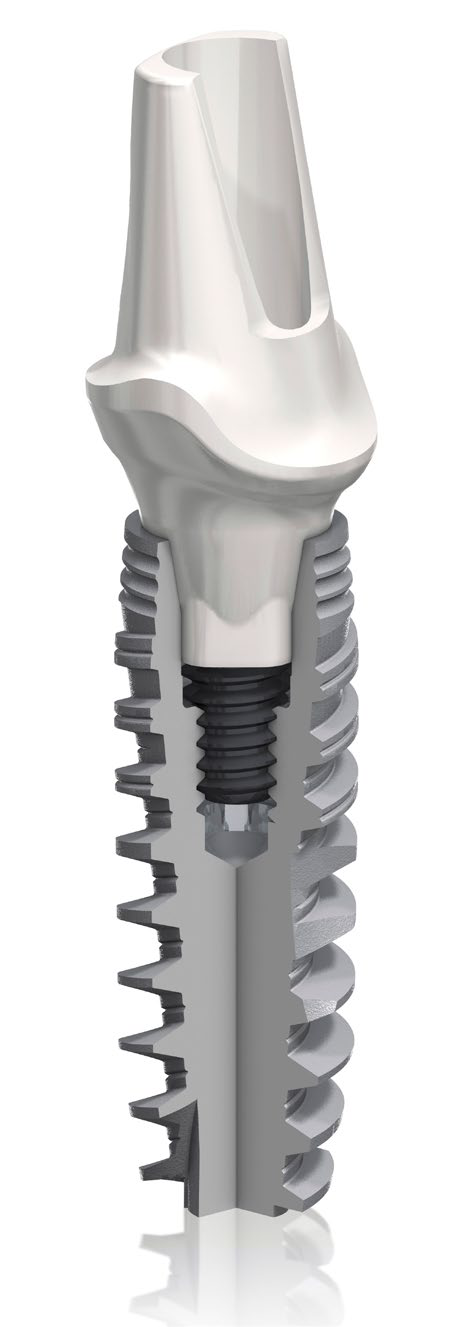
What is a healing abutment?
A healing abutment is a small device used in dental implant surgeries. Its primary function is to promote the healing of soft and hard tissues around the implant and shape the natural gumline. The healing abutment protects the main part of the implant by preventing the buildup of plaque and debris, ensuring a clean and healthy environment around the implant. Typically placed on top of the implant, the healing abutment is slightly wider than the implant, guiding the gum tissue to form the ideal shape. It can be used in both one-stage and two-stage procedures, aiding in the successful integration of the implant into the jawbone and laying a solid foundation for the installation of the final crown.
how to place healing abutment
The installation of a healing abutment is an essential step in dental implant surgery, closely integrated into the treatment process following the placement of the implant into the jawbone. The procedure is performed under strict local anesthesia. The oral surgeon first makes a small incision in the gum to clearly expose the implanted dental implant. The carefully designed healing abutment is then precisely screwed onto the top of the implant to ensure a secure fit. After this step, the gum tissue is meticulously stitched back into place, enveloping and partially covering the top of the healing abutment. This process promotes the natural healing of the gum tissue around the abutment, ultimately shaping the gumline to closely resemble natural teeth, ensuring both aesthetic and functional outcomes.
In a simplified one-stage surgery, the oral surgeon skillfully performs the simultaneous installation of the implant and the healing abutment. The implant is precisely placed into the jawbone, followed by the rapid attachment of the healing cap as a temporary device. At this point, the healing abutment is preset to protrude above the gum surface, maintaining stability as the implant gradually integrates with the bone. Once the implant has fully integrated into the jawbone and reached the desired healing state, the healing cap is gently removed and replaced by the healing abutment. Finally, a custom crown is precisely placed on the healing abutment, completing the entire dental implant process and providing the patient with a renewed smile.
difference between healing cap and healing abutment
The healing cap and healing abutment each have their unique design and purpose in dental implant surgery. The healing cap is small and temporary, designed to protect the implant in the early stages from direct interference, ensuring cleanliness and stability during the implant’s integration with the jawbone. It is commonly used in one-stage surgeries. In contrast, the healing abutment is larger, designed to provide a stable platform, guide the natural healing of gum tissue, shape an aesthetic gumline, and prevent recession. It can be used flexibly in both one-stage and two-stage surgeries.
In terms of installation and function, the healing cap is initially placed on top of the implant until healing is sufficient to replace it. The healing abutment, on the other hand, is installed after the implant has fully integrated with the jawbone, providing a solid foundation for the subsequent crown placement.
the healing cap acts as an early protector for the implant, ensuring a clean healing environment, while the healing abutment serves as a long-term guide for gum healing and shaping, laying the groundwork for the final aesthetic results. Though they serve different functions, both are crucial for the success and aesthetics of dental implants.
cover screw vs healing abutment
In dental implant surgery, both the cover screw and the healing abutment play crucial roles, each serving a unique purpose.
- Cover Screw: Serving as the initial protector of the implant, the cover screw is a small, titanium component that securely covers the top of the implant. It effectively isolates the implant from external contamination, preventing infection and foreign objects from entering the implant. Its design is specifically intended for the early stages of two-stage surgeries, ensuring a clean environment for the implant to integrate with the jawbone.
- Healing Abutment: On the other hand, the healing abutment is a key component in the later stages of the implant healing process. With its broad platform design, it provides stable support for the gum tissue, guiding it to heal naturally and form an aesthetic gumline that mimics natural teeth. Used in both one-stage and two-stage surgeries, the healing abutment is introduced after the implant has fully integrated with the jawbone, facilitating the restoration of healthy gum contours and setting the stage for the final crown placement.
Though they serve different functions, the cover screw and healing abutment work in close harmony to contribute to the success and aesthetic outcome of dental implants.
healing abutment vs final abutment
In the precise process of dental implant surgery, the healing abutment and final abutment serve as indispensable cornerstones, each carrying unique and crucial tasks that guide the dental implant from healing to functional restoration.
Łącznik gojący
The healing abutment, serving as the initial protector following implant placement, primarily aims to guide and promote the natural healing of the gum tissue surrounding the implant. Its broad design provides a stable platform for gum healing while cleverly preventing gum tissue shrinkage, ensuring the implant site remains open and clean during the healing process. During this phase, the healing abutment not only helps shape an aesthetically pleasing gum line but also lays a solid foundation for the subsequent crown installation. It quietly performs its role until the healing phase is complete, after which it steps aside to make way for the final abutment.
Łącznik końcowy
With the successful conclusion of the healing phase, the final abutment, as the ultimate guardian of implant restoration, takes center stage. Unlike the healing abutment, the final abutment is designed with greater precision to perfectly match the crown. It plays a crucial role in supporting and securing the crown, ensuring both functionality and aesthetics during chewing. Based on the solid integration of the implant with the jawbone, the perfect union of the final abutment and crown marks the completion of the implant restoration process. From this point, the artificial tooth functions just like a natural one, providing the patient with a confident smile and worry-free chewing experience.
The healing abutment and final abutment each play distinct but complementary roles in dental implant surgery. The former guides the gum tissue around the implant toward healing, while the latter ensures the success and longevity of functional restoration.
Advantages of Using Healing Abutments in Dental Implant Surgery
- Promotes Healing of Soft and Hard Tissues: Healing abutments act as a bridge between the implant and the surrounding tissues, effectively guiding and promoting the natural healing process of the gum (soft tissue) while supporting the stable integration of the jawbone (hard tissue) with the implant.
- Protects the Implant from Contamination: By securely covering the top of the implant, healing abutments effectively shield it from oral bacteria, food debris, and plaque, reducing the risk of infection and ensuring a clean, sterile healing environment.
- Reduces Occlusal Pressure: During the healing period, healing abutments help absorb some of the occlusal (biting) pressure, thus protecting the implant from potential damage and promoting a smoother bone integration process.
- Ensures Stability of the Implant: Healing abutments provide a stable platform for the implant, helping to maintain its correct position within the jawbone and preventing displacement or loosening, ensuring a smooth healing process.
- Prepares for Crown Placement: By guiding the healing shape of the gums, healing abutments create a solid foundation for the final crown placement. They ensure a perfect fit between the crown and the surrounding gum tissue, enhancing both the aesthetics and functionality of the dental implant.
- Simplifies Surgical Procedures: Healing abutments are designed with ease of use in mind, making them less likely to be clogged by food debris or particles. This helps surgeons use tools like screwdrivers more smoothly during installation and adjustment, reducing surgical difficulty and improving efficiency.
Wnioski
Healing abutments play a vital role in dental implant procedures by promoting the healing of soft and hard tissues, guiding the gum to form an aesthetic and functional shape. They protect the implant from contamination by shielding it from bacteria, debris, and plaque. During the healing phase, healing abutments reduce occlusal pressure, maintain implant stability, and prevent displacement. They also lay a solid foundation for the final crown installation, ensuring a seamless fit with the surrounding gum tissue. Designed for ease of use, healing abutments simplify surgical procedures, contributing to the success and long-term stability of dental implants.

